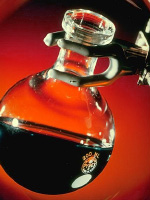 |
 The US Food and Drug Administration
divides food colorants into two categories:
The US Food and Drug Administration
divides food colorants into two categories:
Certifiable Color Additives which
are derived from petroleum distillates or coal tars and are
essentially synthetic chemicals created in laboratories. These
are often referred to as "artificial" colors.
Exempt Color Additives are derived
from plant, animal or mineral sources which have been processed
in some way. The layman might call these "natural"
colors because of their origins, though it's likely they've
come out of a factory or chemical plant just like certifiable
colors.
Certifiable Colors
There are only seven certified color additives
currently used in food:
| FD&C # |
Hue |
Name |
Common Uses |
| Blue #1 |
Bright
Blue |
Brilliant Blue |
Beverages, powders, jellies, confections,
condiments, icings, syrups, extracts |
| Blue #2 |
Royal
Blue |
Indigotine |
Baked goods, cereals, snack foods,
ice cream, confections, cherries |
| Green #3 |
Sea Green |
Fast Green |
Beverages, puddings, ice cream, sherbet,
cherries, baked goods, dairy products |
| Red #3 |
Cherry-Red |
Erythrosine |
Canned Cherries, confections, baked
goods, dairy products, snack foods |
| Red #40 |
Orange-Red |
Allura Red |
Gelatins, puddings, dairy products,
confections, beverages, condiments |
| Yellow #5 |
Lemon Yellow |
Tatrazine |
Custards, beverages, ice cream, confections,
preserves, cereals |
| Yellow #6 |
Orange |
Sunset Yellow |
Cereals, baked goods, snack foods,
ice cream, beverages, confections |
Exempt Colors
The hues of exempt colors are as numerous
as their sources. The most common exempt colors include:
| Name |
Hue |
Source |
Common Uses |
| Annatto |
Orange |
Seed Extract |
dairy products, popcorn oil, butter
mixes, baked goods, icings, snacks, ice cream, salad dressing,
yogurts, |
| Beta-carotene |
Orange |
Carrots |
margarine, non-dairy creamers |
| Beet powder |
Purple |
Beets |
ice cream, cake icings, mixes, yogurt,
gelatin desserts, fruit chews, frozen products, chewable
tablets |
| Caramel color |
Brown
to Red |
Roasted Sugar |
dairy foods, drinks, colas, iced tea,
cocoa, beer, coffee, icings, cereals, popcorn, gravies,
sauces, candies |
| Carrot oil |
Orange |
Carrots |
|
| Carmine |
Wine
Red |
Cochineal (insect) extract |
cake icings, hard candy, bakery products,
yogurt, ice cream, gelatin desserts, fruit syrups, pet
foods, jams/preserves |
| Fruit juice |
Many
Colors |
Fruits |
beverages, jellies, candy, gelatin
desserts, dry mixes, dark chocolate |
| Paprika |
Red-Orange |
Red Peppers |
sausage, cheese sauces, gravies, condiments,
salad dressings, baked goods, snacks, icings, cereals |
| Riboflavin |
Yellow-Orange |
vitamin B2 |
|
| Saffron |
Yellow-Orange |
Crocus Pollen |
|
| Turmeric |
Yellow |
Root extract |
baked products, dairy products, ice
cream, yogurts, cakes, cookies, popcorn, candy, cake icings,
cereals, sauces, gelatins |
| Vegetable juice |
Many
Colors |
Vegetables |
|
Labeling for Exempt Colors
Exempt Colors must be listed in a product's
ingredients list. According to the FDA's labeling rules, they
can be declared in one of these ways: as "Artificial
Color,'' "Artificial Color Added,'' or "Color Added''
(or by an equally informative term that makes clear that a
color additive has been used in the food). Alternatively,
such color additives may be declared as "Colored with
______'' or "______ color'', the blank to be filled with
the name of the color additive.
If a certified color is used, it must
be explicitly declared on the ingredient list, as "FD&C
Red Dye #40" or "Red 40" So if
you are reading a products list of ingredients and all you
see is the nonspecific "artificial color" then you
can be sure it's not a certified color. It may be beet
juice extract, it might be carmine or it could be caramel
color, but it's certain that it's not Red40.
Colorant Uses
Not all colors can be used in all foods (this
is where the food science part comes in) Some colorants
don't tolerate temperature extremes well, some work within
a narrow range of acidity. The food chemist needs to analyze
the food to be colored for fat content, proteins and enzymes,
expected temperature ranges, exposure to light and heat and
desired shelf life. From all those variables (and the desired
color) can they determine which food colorant is best suited
for the job.
You may have noticed that Annatto is commonly
used to color dairy products an orange or yellow color. This
is because Annatto binds to the proteins in milk and is particularly
well suited for that task. Tumeric tends to fade with light
exposure so you won't find it in products that will be stored
in a clear container on an open shelf. Carmine, because it
is derived from insects, can never be consider Kosher. While
the food scientist has a broad palette of colors to chose
from, it takes a deeper study of the requirements to come
up with the optimum colorant.
|
 |
